[WIP] Atlas Contest - Yréas Kóltyn Village (Kingdom of Enía, Gold Coast region of Dóriant)
When I was working on Fon'Anar, my elven farming village in Verinress'Arl on Artemisia, I had an idea for a different approach for an elven village that I wanted to try next.
This little village of Yréas Kóltyn is set in the Kingdom of Enía, a northern country in the Gold Coast region of Dóriant that I am submitting as parent (or great grandparent) map to the Atlas. It's a religious community overseen by an archdruid who oversees religious observances at a Great Henge located in the Firessi Woods. For context, it's located in the yellow box on this map:
I did the map using the Forest Trails annual, with heavy assist from the Darklands City annual. Here's the map in progress:
And here is a more battlemap-ready version of it with the trees (and treehouses) hidden, and just stumps and shadows shown:
The treetops and treehouses are all on a single layer to make it easier to toggle them on and off.
The idea of the village is that they've grown up in support of the temple in support of the elves who make pilgrimages there for the opportunity to experience religious services in one of the holiest places in the kingdom.
Here's the temple close up:
In my campaign world, the elves have seven gods, which is why this has seven standing stones in the center ring, then seven arches and seven stones in the middle ring, and then fourteen arches in the outer ring.
The archdruid's home also serves as a sort of local government for the community. It's the only treehouse home accessible with proper stairs. All of the other treehouses have wooden ladders or rope ladders that can be pulled up to impede access from intruders. Here's the archdruid's home:
The other buildings on the ground here are stables (#3), an inn (#4), and a general store (#5).
The villagers live somewhat communally. Since it would be kinda dangerous to cook food in a treehouse, there's a common kitchen and Great Hall. Everyone has a job, and for some, it's to work in the kitchens to cook for the village -- kinda like the dining commons at a university, perhaps.
Here are the "commons." It includes a small aqueduct to bring fresh water to the kitchens (7) and community baths (9). Dining is in the Great Hall (8). On nice evenings, a bonfire can be lit (10), around which the elves often sing and dance.
Most of the elves live in multigenerational treehouse homes. There are a few neighborhoods of these homes in the village, and residents can walk through their neighborhoods on elevated bridges without needing to go down to the ground. Here's an example of one of those neighborhoods:
I was going to add lots more trees throughout these neighborhoods, but they kind of distracted from the homes themselves.
Since the treehouse homes wouldn't have cooking or fireplaces, I guess these residences shouldn't have chimneys. I tried to cover the chimneys with upper canopy foliage, but I missed a bunch.
I think there are 28 residential treehouses (excluding three attached to the archdruid's that I thought might serve as guest accommodations for VIP pilgrims. They're meant to be multigenerational homes. In calculating the village's population, many residents do you think I should assume per residence?
Any thoughts or feedback?


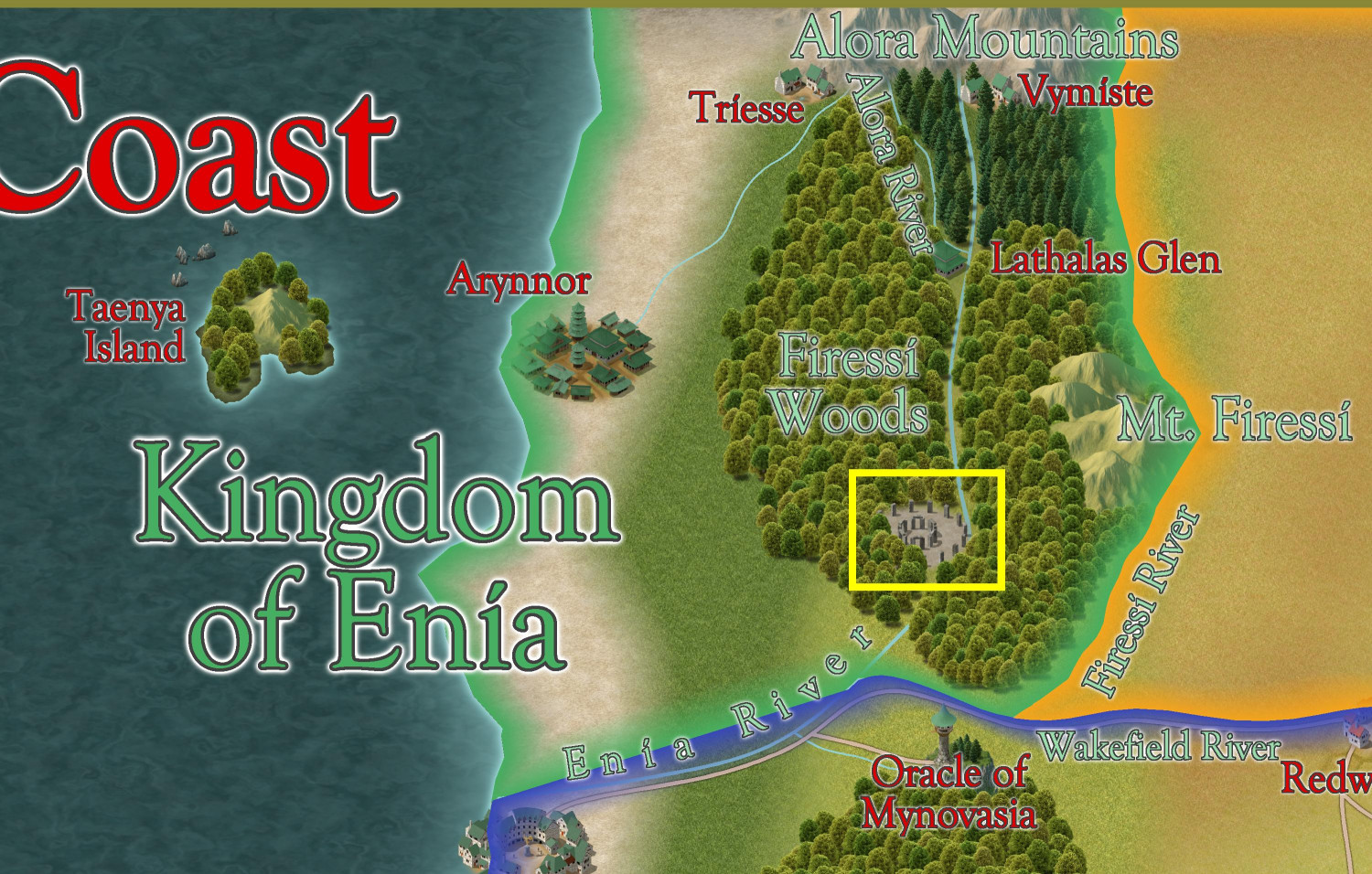
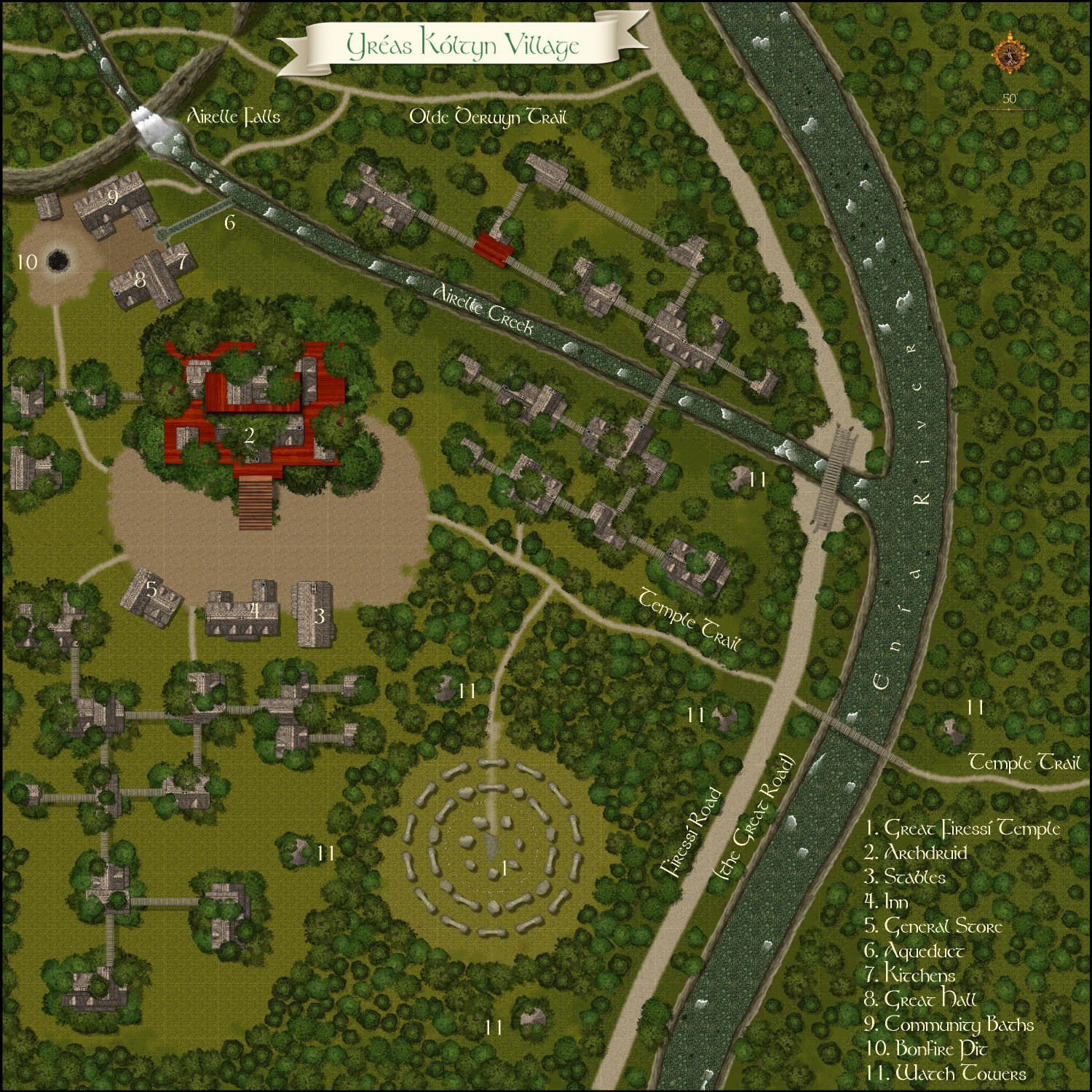
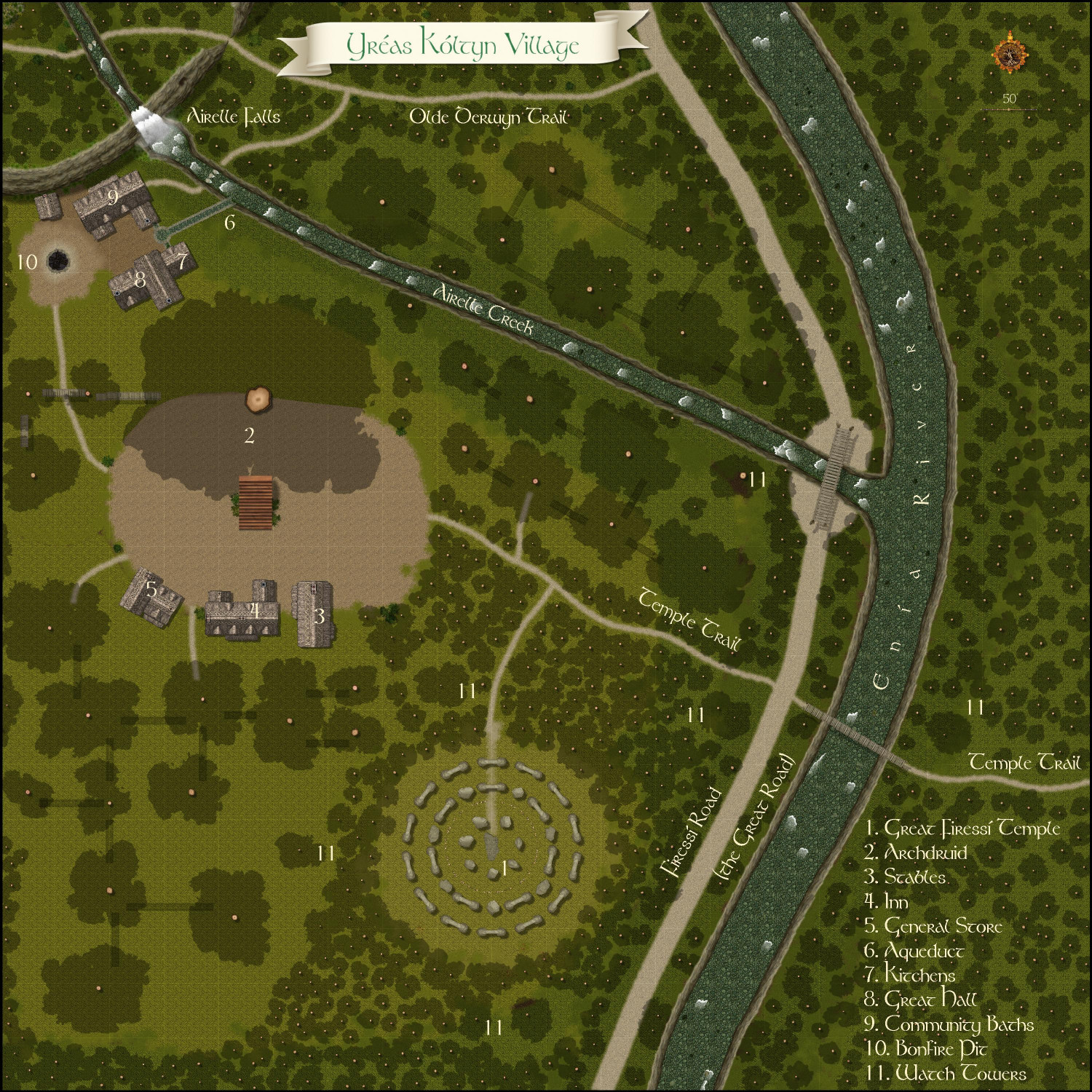
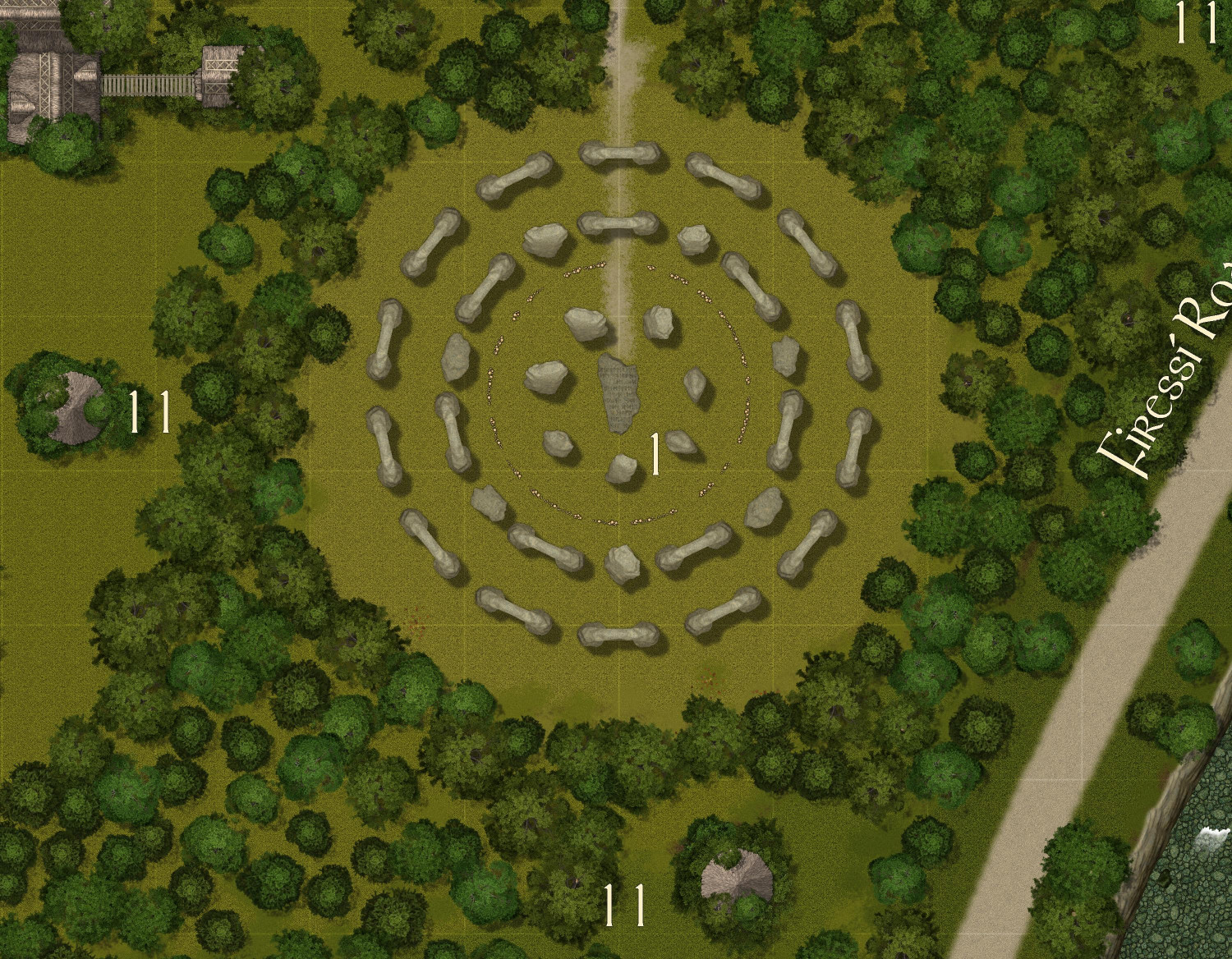

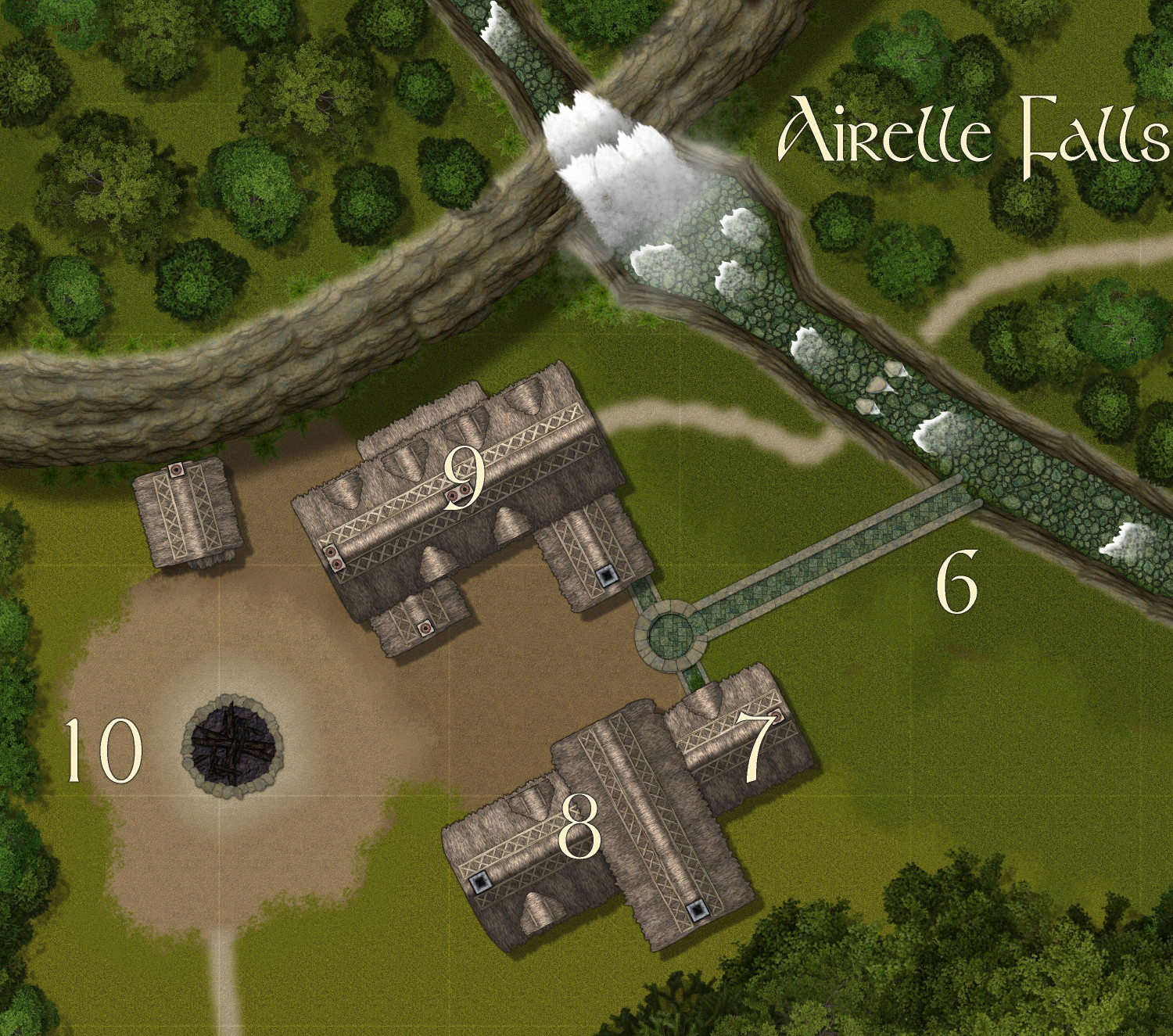
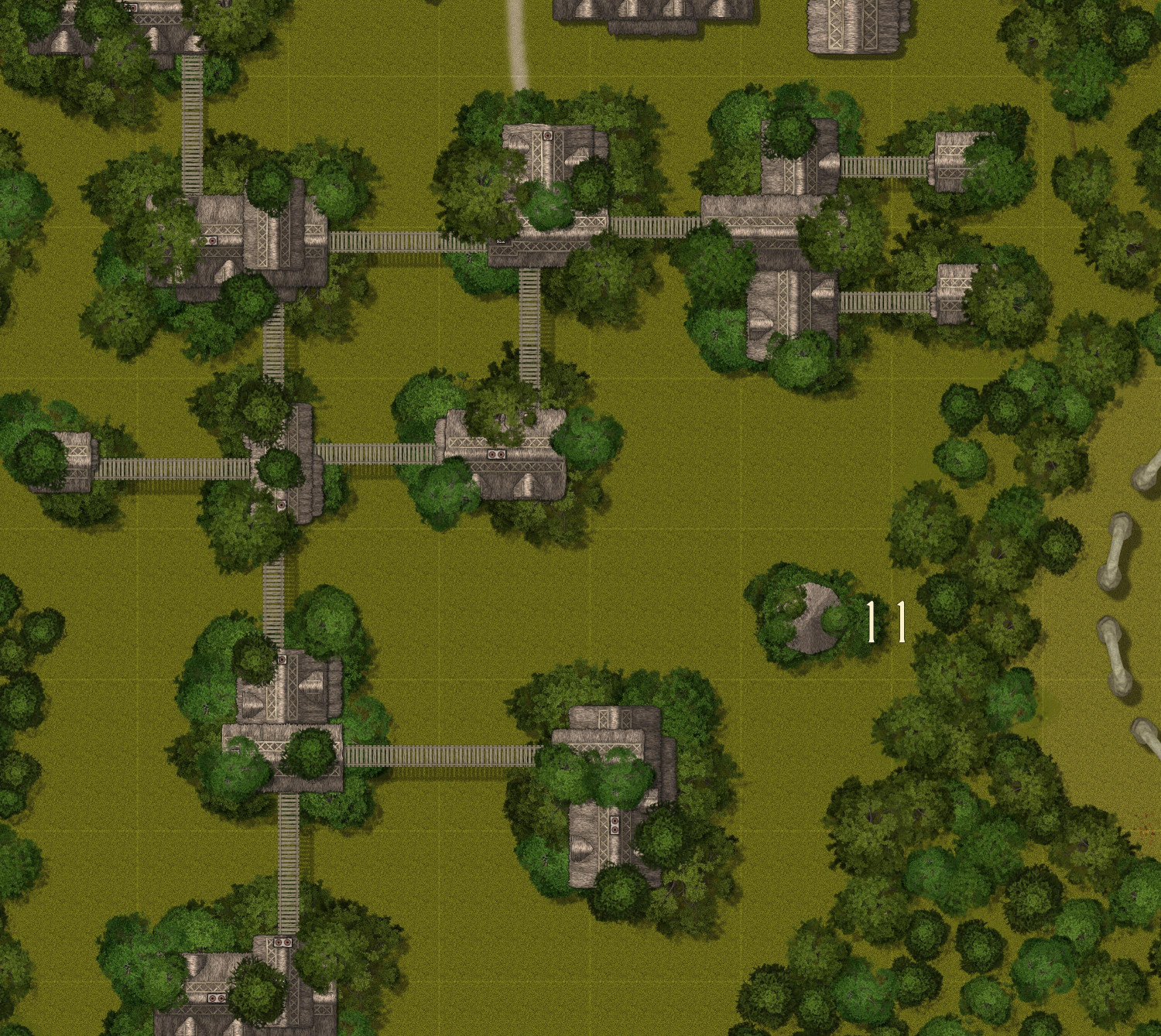


Comments
Related to this village: I am planning on submitting an intermediate map of the Kingdom of Enía portion of the Gold Coast. And now I'm thinking that I might also do another map of just the Firessí Woods. I think it might be easier to do the Firessí Woods map now than after this temple village is added to the Atlas.
If I do create a Firessí Woods map, are there any sorts of adventure hooks or mapping possibilities you'd recommend including? I have the Tempuwari Ruins, which were meant to provide a place for an adventure reminiscent of the opening scene of Raiders of the Lost Ark. Other than adding a few more tiny elven hamlets, and maybe a few cave openings in hills, are there other mapping/adventure hooks you'd like to see?
In terms of what you want to put into your write-ups for the Atlas, that's entirely up to you (within any existing constraints that previous mappers may have set for the region). I tend to go with things that interest me, either that I've developed in the past, or had as ideas previously, or that have been suggested by rolls on random tables (or similar RPG mechanics). You may find those ideas also come to influence changes in how the maps look though, so beware 😁!
With the Elven village map, the linking aerial walkways seem both a little too wide, and much too grid-rectilinear right now. The latter aspect jars with the far more free-and-easy surface pathways, and while the nature of the walkway symbols means they will always be less curving, their long straight tracks don't look so good to me right now. It may be worth experimenting too with some scattered trees/bushes around and even under the walkways (some are long enough they probably need support from below of some kind, for instance), as well as between the arboreal buildings. Tree houses really shouldn't be all that easy to spot, although mapping often brings compromises that aren't wholly realistic, of course.
Making some final adjustments while writing up the description to submit this. Moved some of the treehouses around to make it slightly less grid-rectilinear, though I can't do too much without essentially starting from scratch. Even though the bridge symbols are short sections, it doesn't have curved sections, so my options for winding elevated walkways is limited. I do have ideas for how to do that next time, but it's another thing I'm not sure I can implement in this map without starting over. I also added some more trees and bushes below some of the longer walkways and around the neighborhoods, but not too much -- didn't want to totally hide the village. I agree that the typical wood elf village would be concealed enough that most non-elves walking by probably wouldn't notice it, but since this village is a major destination for pilgrims because of the temple, it's probably less concealed than most. I also added more to the upper canopy to hide the chimneys of the treehouses where lighting fires wouldn't be advised.
Here's how it now stands:
And here's a battlemap with the "Tree Canopy & Treehouses" layer hidden:
You can always conceal the missing bends and corners with trees next time, of course, but this does look more natural now.
One option for having a more "realistically" vegetated treehouse settlement would be to layer the canopy cover, and use map toggles to hide various of the layers as you descend through - including to show the forest floor as you have done this time, ultimately. This needn't be too complex, as a simple upper level of tree cover might be the only additional layer you'd need. That could hide everything, as it would be with a solid forest cover. Then toggle that top layer off to reveal the main houses and walkways (much as you have here), still with the missing walkway bends "hidden" by the next level down of the canopy trees.
In terms of those bends, I haven't tried, but at this kind of overall map scale, you might get away with artificially shortening some of the walkway segments by using separate X and Y scaling for the symbols, and using each short symbol as one little part of an arc. You would have to overlap the part of the inner areas on the curves too, so again an experiment to try would be advisable first. It may not work, of course, and probably wouldn't once zoomed-in even a little, but it could be worth trying.
I do have separate levels of the canopy -- it's how I have foliage above and below each level of the multilevel Druid's home. I would just need to create separate Layers for it. Maybe next time.
you might get away with artificially shortening some of the walkway segments by using separate X and Y scaling for the symbols, and using each short symbol as one little part of an arc
Interesting idea! I probably won't adjust this map for it, but I'm going to experiment now anyway so that the approach is in my bag of tricks for next map.
Didn't work, unless I'm misunderstanding the approach you're recommending. You either get a shorter bit of bridge with narrower slats, or one just as long but half as wide:
Depending on the style I use, I could always use the Mike Schley wooden steps with a technique similar to the railroad tracks that Remy demonstrated in the Silver Mines and Rails & Trains tutorials.
Yeah, it's the shorter piece with narrower slats I was meaning. I knew it wouldn't look great zoomed-in, but it might be OK at a whole-map level.
The rails idea did occur to me, although I wasn't sure if there were single planks in a suitable format in this style (albeit again, at a general map level, you could probably get away with a simple rectangle of suitable colour), which is why I didn't suggest it earlier!
Yeah, I could use the same wooden fill that I used on the platforms at the Archdruids, and put it on a sheet with a little beveling. And then turn it into a symbol like Remy did in those tutorials. Next time. ;-)
I literally had dreams last night about different elevated walkway techniques. I would mock some up but my roommates are busy decorating for Halloween (they started in August) and I’m staying out of the way.
One simple idea is to use these bridge symbols, but where they branch off or turn, draw in small wooden landings like you would on a staircase that turns.
I also thought about drawing a solid 5’ wide line with a wooden fill. (This would also let you have a curvy bridge.) If you want slats, my first thought was the color key effect, with polygon magenta blocks copied down the path — but changing the line style to dashed lines would probably be easier. You could still draw in platforms at the turns if the “planks” look weird there. If a drop shadow doesn’t look right, you could create a shadow by copying your bridge to a Shadow sheet, moving it to be offset the way you want, change the fill to be solid black or gray, and then add a transparency effect.